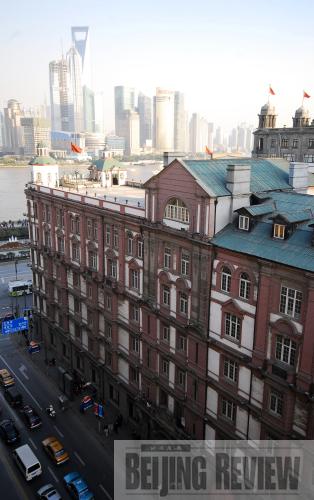|
 |
|
UNDER CONSTRUCTION: The construction site of Shanghai's 2010 World Expo on January 1, 2009 (CAI YAOFANG) |
It is no secret that Shanghai's drive to hold a successful World Expo in 2010 has been generously backed with human resources and money by the Central Government. But it might come as a surprise to Westerners that Shanghai has long had a fascination with the event that extends back well into the 19th century.
 |
|
FACELIFT FOR PAGEANT: Peace Hotel, a landmark building on the Bund in Shanghai, undergoes a full renovation and will reopen in time for the Expo 2010 Shanghai (XINHUA) |
The World Expo's beginning, which debuted in London in 1851, coincided with China's first attempts to reach out to the rest of the world. Shanghai was the city spearheading China's modernization drive in the 19th century and the city, undergoing the growing pangs of industrialization, was amazed by new inventions and technologies from Western countries, such as Britain, France, the United States and Germany. It was natural, then, that the Central Government reached out to the citizens of Shanghai to design the China pavilions during early World Expos. The Qing (1644-1911) government sponsored the construction of the China pavilions during the Expos, first in Vienna in 1873 and then again in the 1876 Philadelphia fair. Both pavilions were constructed in Shanghai.
Since the founding of the Republic of China in 1911, chambers of commerce, mainly composed of Shanghai merchants, sponsored and organized the construction of China's World Expo pavilions. During this period, Shanghai's factories, farms, stores, research institutes and churches were invited to donate exhibition items to the endeavor.
While designing and building the pavilions, Shanghai residents looked forward to one day hosting the event in the early 20th century. This desire was given form in literature from the period. In 1902, Liang Qichao, one of the most influential scholars at the turn of the century, depicted a future in which the city would host the grand Shanghai Expo 60 years thence. In his work, the whole city became the site for the grand event, which even hosted forums and seminars on natural and social sciences. Then in 1905, Shanghai-based novelist Wu Jianren rewrote the 18th-century masterpiece The Story of the Stone, where the novel's hero Jia Baoyu visited a World Expo staged in the city's Pudong area. In 1910, another Shanghai novelist, Lu Shi'e, predicted in his novel New China that the World Expo would come to Shanghai 100 years from then, which now appears to be a prescient prediction.
In the last 150 years, Shanghai has made a name as the most open to the outside world among Chinese cities. A welcoming attitude toward globalization is in the blood of Shanghai residents. Most people in the city believe that only after the city joins the global economic system can they obtain opportunities to start businesses and develop themselves. And this enthusiasm also explains the city's love affair with the World Expo.
History professor Jeffrey Wasserstrom with University of California, Irvine, who has been following Shanghai's preparations for the 2010 Expo, recently published a book called Global Shanghai, 1850-2010. In this book, Wasserstrom regards the World Expo 2010 as an important mark of Shanghai's re-globalization. He praises the city's efforts to retake the center stage and calls Shanghai a "futuristic city" in the 21st century.
The Expo's 4-square-km site will be located on the banks of the Huangpu River between the two landmark Nanpu and Lupu bridges. Running several hundred meters wide at the Expo site, the Huangpu River defines Shanghai as much as the Thames defines London, the Seines defines Paris or the Hudson defines New York City. Besides providing grand views for the city's visitors, the river was also a cradle of China's early industrialization. A 150-year-old shipyard on the river was moved to make way for the Expo. The old site of Jiangnan Shipyard, a ship building factory founded in 1865 that built several 10,000-ton ships for the United States, including the Mandarin, Celestial, Oriental and Cathay, has been transformed into a major event venue. The shipyard is building a new home on Changxing Island near the mouth of the Yangtze River, which will soon become the world's largest shipyard. After serving in the Expo, the shipyard's old site will become a museum of Shanghai's early industrialization, exhibiting Shanghai's prominence in the world's early globalizing economy and the city's long history as an international trading port.
|
